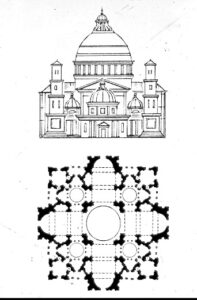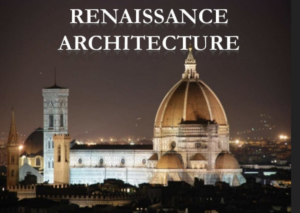Design Thinking In Architecture
Design Thinking In Architecture:
Building your home or any infrastructure is a costly endeavor. It begs the question: what can be done to ensure a well thought out project? How do you maximize on your investment, while minimizing cost? In this blog, I will address these question and present a brief summary on how design thinking can be utilized to maximize on your investment. Design thinking is vital tool that helps you evaluate many aspects of a project. In fact, the process itself, engages a wide variety of data holistically and combines the art with the science; creating a foundation for a well thought out process. Let’s start with a bit of history.
In the Renaissance period for example, architects, artist’s and sculptor’s alike, created their designs with sketches, hand drawings, diagrams and even a preliminary study models. They learned that the process of creating something of value required an understanding of form and function, but also how to produce an aesthetically pleasing work. It was a discovery that facilitated and built upon layers of knowledge and testing.
Design thinking blossoms in the Renaissance period and influenced all disciplines. In architecture it starts with a human-centric approach. A way of thinking that focused on the human being as a prototype to design. The human body was seen a perfect model of proportion, form and function. It should come as no surprise that the solutions developed during the Renaissance period, gave rise to a quality of human life, and changed the known world. It also provided immense improvements in science and art — even serving as an education program for various trades or disciplines. Functioning as a mentorship program during this period in history to pass along what was learned.
Why Design Thinking:
Design thinking throughout history was utilized in and outside the strict boundaries of architecture. It is also interesting to note how design developed in the Renaissance period and extended itself in broad ways. In addition, it can be said that a design mindset itself serves as a creative tool that encompasses the science and art to solve problems and develop meaningful strategies. Utilizing this tool should reflect a process that creates immense opportunity to add value and set a design direction. Perhaps most importantly, it integrates the art with the science of building. However, you have to apply it in order to achieve the benefits. Unfortunately, so much of our build environment today, seems to under value this tool. Perhaps this is why soo many of our cities and towns are poorly designed and unhealthy places to live or work?
Design thinking is like a muscle that grows stronger when used. It broadens your capabilities to use design as a way of creating a rational order and process. Any tool that helps to shape and develop creativity in a meaningful way should be considered valuable. This is not about creating a pretty picture, but producing a work that is authentic and functions well. Where all the parts work together in harmony. Although each project is different, we can learn a lot about how to make improvements to our built environment by using this design mindset and applying it. This approach simply serves to connect as many dots you can and enhance the discovery process. To seek new and innovative approaches to improving the quality of life.
How Design Thinking Can Be Used in Architecture:
- Diagrams that facilitate the development of the building program
- Align functional requirements with aesthetics
- Solutions focused development process (divergent and convergent thinking)
- Utilizing the power of sketch and planning to clarify and advance objectives
- Seeks to develop a human centric solution
- Evaluating function, program, site and aesthetics as a single entity
Developing an architecture project requires careful assessment of program, form, and function. It also requires an understanding of how human beings will live or work in that building. This is often a challenge that presents itself in this modern age. To combat this mediocre tendency we should ask what is needed physically, even mentally or psychologically. A responsible design for human beings should engage many questions of ourselves and the client. In addition, the lessons of the past, can and should be applied to refine our present day solution(s).
A Design Mindset Approach:
Design thinking in architecture, should not be thought of as a formula, or a mathematical equation that can be applied to solve for an unknown. It’s also not a factory or assembly line process. It has more to do with developing a harmony among the project parts and interfacing with human beings. Our process at Arc Castle Studio, utilizes an approach of generating, synthesizing and evaluating through a collaborative process with the client and consultants. We use critical thinking and simple tools like sketches, drawings, diagrams and even hand crafted study models. We explore, learn, discover, and connect the dots of our journey to paint a picture that creates the clients individual story, to meet their criteria. But most important it is a work by human beings, for human beings.
Design thinking can also serve to minimize risk, through its design process. It considers many options toward achieving a given solution(s). As human beings we need to think through the project goals and objectives before we can advance and build. (especially when we build!) When we rush to build, there can be long term consequences that cannot be easily reclaimed. When there is no building program, or design-thinking, the process is usually being driven by a one size fits all approach. However, Design thinking represents an effort and work that seeks to create a meaningful balance of the art with the science. Also, the financial benefits and value is not arbitrary, but enhances the esthetics and function. The investment in our infrastructure has long term ramifications and benefits; not only in the current culture, but also upon future generations.
Summary:
Design thinking has broad applications. It serves to solve problems and produce lasting value. This represents a process of thinking holistically, to align all the parts of the project holistically. It’s not skin deep beauty, but has an authentic deep meaning, purpose and application as it interacts with human beings. A good work can be discerned by observing how well its form is suited to its function, and aesthetics. If you want to maximize your efforts to improve anything, utilize a design thinking mindset; seeking to learn, change, and apply lessons learned through analysis. Never settle for the mediocrity of the status quo.



Design Thinking In Architecture Read More »


